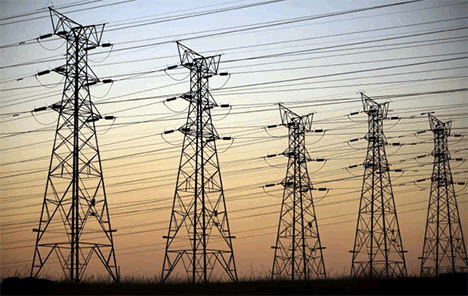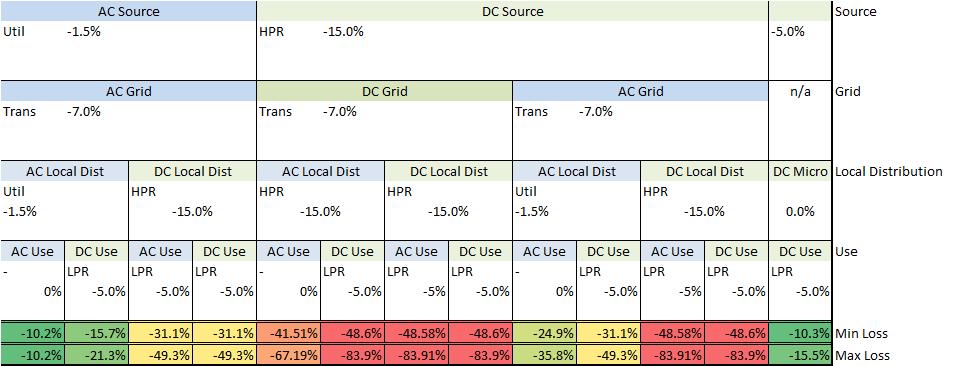
Transmission and Distribution(06 Aug 2010) Summary
Wikipedia overview. Bing Search "Power Line Transmission Loss" |
|
|
AC and DC Transmission Most power distribution is done over an AC grid. Most electricity is generated from primary energy sources using steam turbine generators, and an AC grid couples efficiently and cheaply with AC power sources. Furthermore, AC power can be manipulated cheaply and efficiently to minimize transmission losses. Power loss in a conductor is P = I2 * R where R is the resistance of the conductor. Power loss is proportional to the square of current I, so lower current will be more efficient. P = I2 * R = I * V, so to transmit power P, current I can be minimized by increasing voltage V. AC voltage is cheaply and efficiently amplified by a transformer. So the combination of AC power generation with cheap and efficient voltage conversion for transmission, favors distribution of AC power. However, many load devices run on DC so conversion to DC at the load adds back some inefficiency. Solar PV sources generate DC, and an additional inversion step from DC to AC is needed when used with an AC transmission system, adding incremental inefficiency of 15% - 25% for high-power conversion. |
DC Distribution High-voltage DC systems are also in use for transmission. Voltage amplification for these systems is more expensive than transformers used for AC, but the tradeoff between source and load conversion efficiency vs. transmission efficiency gives them advantages depending on configuration. Comparisons are shown in the analysis below.
|
|
Photovoltaic power, DC Grid, Electric Vehicles? Since PV solar cells generate DC, and electric vehicles run on DC and much load equipment runs on DC, would it be possible to distribute and use DC service to increase power efficiency with EVs and other DC equipment?
|
|
|
AC Scheme |
DC Scheme |
|
Power Generation AC Primary Steam Generation: Coal, Natural Gas, Nuclear, Solar Thermal, Solar Tower. Steam conversion of coal and natural gas results in about 66% loss of BTU between commodity and electricity generated. AC Direct Generation: Hydroelectric, Wind turbine. |
Power Generation DC Direct Generation: Solar Photovoltaic, Concentrated. Availability limited to daytime hours, and variable availability due to weather and season. |
|
AC Grid Distribution Voltage is amplified to reduce current. Current is reduced in order to minimize line IR losses. AC generation sources use passive transformers. DC generation sources require a DC-AC inversion and step-up (about 10% loss). About 7% Transmission Loss |
DC Grid Distribution Voltage is amplified to reduce current. Current is reduced in order to minimize line IR losses. AC grid distribution system is already ubiquitous so grid distribution from AC sources on a DC grid is not considered here. DC generation sources require voltage step-up (about 10% loss) About 7% Transmission Loss |
|
AC Local Distribution AC local distribution from AC grid requires transformer voltage stepdown to local (120, 220v AC etc.). AC local distribution is already ubiquitous so local distribution of AC from a DC grid is not considered here. |
DC Local Distribution DC local distribution from DC grid requires voltage stepdown (likely 48v DC). (about 10% loss) DC local distribution from AC grid requires AC-DC conversion to local (likely 48v DC). (about 10% loss) |
|
AC Local Usage AC is used directly for motors, pumps etc. Motor efficiency is not considered here beyond power distribution. |
DC Local Usage Home/office/industrial electronic equipment, computers/servers, televisions, lighting etc. need regulation to operating voltage (about 10% loss). If local distribution is AC, then AC-DC conversion is also required. Electric Vehicle battery requires charger regulation (about 10% loss). If local distribution is AC, then AC-DC conversion is also required. (As noted elsewhere on this site, generation capacity, grid capacity, and grid scheduling and management all need to increase proportionately with EV deployment.) Motor efficiency is not considered here beyond power distribution. |
Estimated comparison of source-to-use loss shows how conversions build up loss. High-power inverter and step-up/down competitive with transformers would make a key difference. Efficiency of load device is not incorporated. Click figure for spreadsheet.

Util = Utility transformer step-up/down. HPR = High-power Inverter/regulator, step-up/down. Trans = Transmission Line Loss. LPR = Low-Power inverter/regulator, step-down. AC/DC Use = power input terminals to usage device. Min/Max Loss = accumulation of range of losses through the delivery chain.
